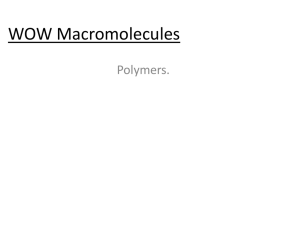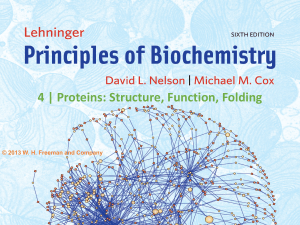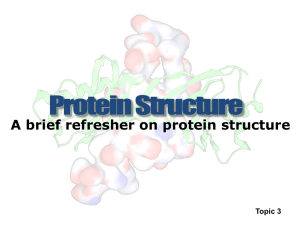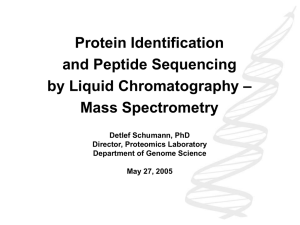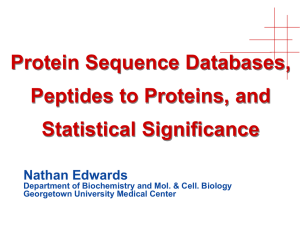2차 구조
advertisement
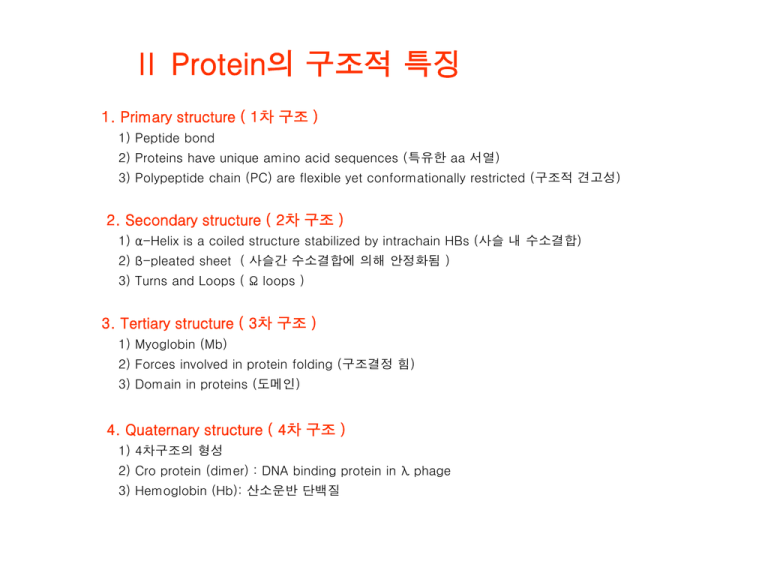
Ⅱ Protein의 구조적 특징 1. Primary structure ( 1차 구조 ) 1) Peptide bond 2) Proteins have unique amino acid sequences (특유한 aa 서열) 3) Polypeptide chain (PC) are flexible yet conformationally restricted (구조적 견고성) 2. Secondary structure ( 2차 구조 ) 1) α-Helix is a coiled structure stabilized by intrachain HBs (사슬 내 수소결합) 2) ß-pleated sheet ( 사슬간 수소결합에 의해 안정화됨 ) 3) Turns and Loops ( Ω loops ) 3. Tertiary structure ( 3차 구조 ) 1) Myoglobin (Mb) 2) Forces involved in protein folding (구조결정 힘) 3) Domain in proteins (도메인) 4. Quaternary structure ( 4차 구조 ) 1) 4차구조의 형성 2) Cro protein (dimer) : DNA binding protein in λ phage 3) Hemoglobin (Hb): 산소운반 단백질 Ⅱ Protein의 구조적 특성 1. Primary structure (1차구조) □ Amino acids are linked by peptide bonds to form polypeptide chains 1) Peptide bond (1) Peptide bond or amide bond (-CO-NH-) (2) Peptide (Tyr-Gly-Gly-Phe-Leu : YGGFL) 가. N-terminal and C-terminal amino acid residues 나. 구조를 그릴 줄 알아야 함 (NCC-NCC-NCC-NCC-NCC) 다. Polypeptide chain의 일부 라. Dipeptide, tripeptide, pentapeptide 등의 Peptides □ 생리활성 물질 가) L-Asp-Phe-Me ester : 감리료 나) γ-G lu- Cys- Gly (GSH) : 환원제 다) Oxytocin (9 aa, cyclic) : 분만촉진 라) Leu enkephalin (Tyr- Gly-Gly-Phe-Leu) : pain control (brain, nerve) 마) Insulin : hormone (혈당 조절) □ Disulfide bond (-S-S-) 가. Cystine (Cys-Cys) 나. Intracellular protein은 없고, extracellular protein은 종종 가짐 □ Polypeptide chain (PC) : 50-2000 aa (ave, mw of aa : 110): Example : aa 잔기가 124인 PC에 대하여 가. 분자량 (MW)은? 나. 이 분자량을 dalton 또는 kd로 표시하면? 2) Proteins have unique amino acid sequences (1) F. Sanger의 insulin의 aa 서열 결정 (1953) -This work is a landmark in biochemistry because it showed for the dirst time that a protein has a precisely defined amino acid sequence. (2) aa 서열의 중요성 가. Provide mechanistic action of protein (enzyme) 나. Determine 3D structure: polypeptide의 folding에 중요함 (functional character) 다. 분자병리학에 이용 (molecular pathology) - Sickle-cell anemia (RBC) (HbA의 b-chain Glu6-> Val6로 변형) - Cytolic fibrosis(낭포성 섬유증)은 하나의 aa이 달라짐에 따라 일어나는 비정상적인 병리현상 라. Reveal much about its evolutionary history (진화과정에 대한 정보제공) 3) PC are flexible yet conformationally restricted (1) C-N bond는 partial double bond character (resonance structure) 가. Rigid an planar structure 나. 6 atoms가 planar array를 함 다. Two possible conformations (trans, Cis) 가) Trans (two Cα atoms are on opposite side of the polypeptide bond) 나) Cis (same side) 다) Almost all peptide bonds in proteins are trans (2) Freedom of rotation about two bonds of each aa 가. Allows proteins to fold in many different ways. 나. N-Cα (φ: phi: -를 선호), Cα-C (ψ: psi: +를 선호) 다. Rotation 가) (+) values : a clockwise rotation about either bond as viewed from the front of the back group 나) (-) value : a countclockwise rotation... (3) Romachndran diagram: Three-quarters of the possible (φ, ψ) combinations are excluded simply by local steric clashes (4) Folding 되지 않은 PC로부터 생물학적으로 활성이 있는 PC로 folding은 제한적 가. The rigidity of the peptide unit 나. Restricted set of allowed φ and ψ angles 2. Secondary structure (2차구조) □ PCs can fold into regular structures such as the alpha helix, the beta sheet, and turns and loops. 1) α-Helix is a coiled structure stabilized by intrachain HBs. • α-helix 를 나타내는 모델 • 첫번째 aa의 CO와 다섯번째 aa의 NH와 HB형성 • α-helix의 다양한 모델 • Ramachandran diagram • Protein에서 a-helix의 형태 2) β-pleated sheet (사슬간 수소결합에 의해 안정화됨) • β-sheet 구조 • 역평형 구조 • 평형 구조 • 혼합 구조 • β-sheet의 표시 및 존재형태 • Fatty acid binding protein 3) Turns and Loops (Ω loops) • β-turn 구조 • Ab 표면에 존재하는β-turn 구조 4) Various protein structures 단백질의 역평행 ß-병풍 구조의 예 단백질 내에 있는 이른바 격자무늬 모양의 역평행 ß-원통구조의 예 3. Tertiary structure (3차구조) □ Water-soluble proteins fold into compact structure with nonpolar cores 1) Myoglobin (Mb): an example of protein structure (1) (2) (3) (4) (5) α-helix가 8개로 전체 aa의 70%로 구성, 나머지는 turn과 loops 153개의 aa으로 구성 Heme group을 가지고 있다 Fe(II)는 6개의 배위결합을 한다: N x 4, His F x 1, O2 x 1. 근육에서 산소의 저장을 하는 곳으로 산소와의 결합은 곡선식이다. 2) Forces involved in protein folding (1) (2) (3) (4) (5) 소수성 상호작용 (hydrophobic interaction) 전기적인 상호작용 (electrostatic interaction) 금속이온 결합 (Metal ion coordination) Hydrogen bond (Hydrogen bond interaction) 이황화결합 (disulfide bond) 3) Domain in proteins (1) Some PP fold into two or more compact regions that may be connected by a flexible segment of PC, ranging in size from about 30 to 400 aa residues (2) 면역세포 표면의 CD4 부분 4. Quaternary structure (4차구조) □ Refers to the spatial arrangement of subunits and the nature of their interactions. 1) Constructions of 4 structures (1) Hetero or Homo 구조 (2) 이량체(dimer), 삼량체 (trimer), 사량체 (tetramer) (3) 다른자리 입체이성 (allosteric) 2) Cro protein (dimer): DNA binding protein in λ phage 3) Hemoglobin (Hb) (1) 가장 대표적인 4차구조 (2) α2β2 로 구성 (3) α(141 aa), β (146 aa)는 Mb (153 aa)와 비슷하다 : aa 의 서열은 Mb와 거의 동일함 (4) 산소의 결합 형태가 Cooperative binding (협동적 결합) Ⅲ. AA sequence of a protein determines its 3D structure 1. A study by Christian Anfinsen ( 3차구조 결정에 aa의 서열이 중요함을 입증 ) 1) Ribonuclease (RNase): 124 aa residues 2) Urea (8M) or Guanidium HCl (6M) in ß-ME 처리 : reduced form ∴ Dialysis (Urea 와 ß-ME 제거) : 활성이 있는 형태로 재생 3) Urea가 존재 시 산화: 단지 1% 정도의 활성 유지 4) Scrambled RNase를 소량의 ß-ME로 환원: 100% 활성화 ∴ The native form of RNase is the thermodynamically most stable form. 2. AAs have different propensities for forming α-helices, ß-sheets and ß-turns 1) AA는 각각 2차 구조를 결정하는 성향이 상이 2) 2차 구조는 연속된 6개 정도의 아미노산 잔기로 예측 가능 3) 6개 정도의 아미노산 잔기로 예측한 2차 구조는 Protein 에 따라 상이 3. Prediction of 3D structure from sequence remains a great challenge. 1) ab initio prediction ( 처음부터 예견하는 방법) - Computer-based calculations are employed ; limited by vast number of possible conformations. 2) Knowledge-based methods ( 지식을 근거로 하는 방법들) - an aa sequence of unknown structure is examined for compatibility with any known structure of proteins.



